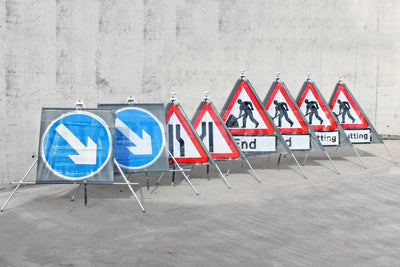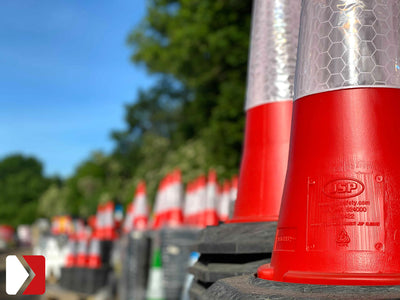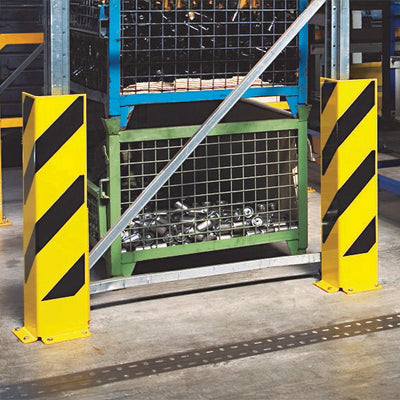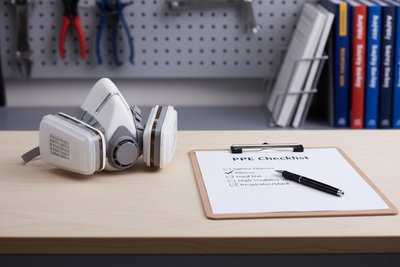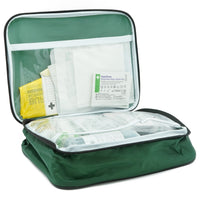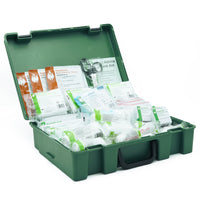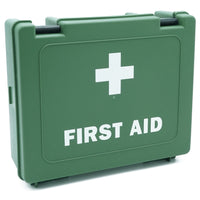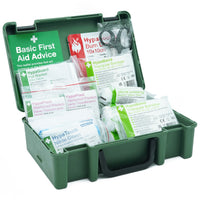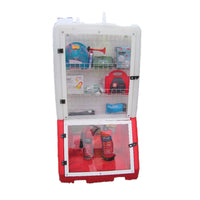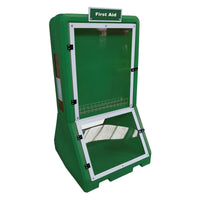British Standards Compliant First Aid Kits Contents
The Contents of a Comprehensive Office First Aid Kit In The UK
Maintaining a safe and prepared workspace is essential for any business in today's busy workplace environments. From minor incidents to potentially catastrophic emergencies, having a well-stocked first aid kit can positively influence the outcome of an injury. It can help stabilise and speed up the initial recovery, and likely mitigate the risks of developing more severe long-term consequences.
This blog post explores what an office first aid kit needs to meet British Health and Safety Regulations, considering different workplace settings and their specific risks.
Whether you're updating your existing supplies or starting from scratch, discover the products needed to meet UK first aid regulations and specific workplace safety needs. We will explain why you need first aid kits in your workspace, what should be inside them, and how many you need.
Why Does Every Office Need a First Aid Kit?
Having a first aid kit in the office allows first aiders and employees, in general, to respond immediately to minor injuries and illnesses. This helps to reduce pain in the short term and prevent conditions from worsening. Quick access to first aid supplies can significantly reduce recovery time and improve employee well-being while injured.
Furthermore, and perhaps more importantly, in the UK, employers must adhere to the UK Health and Safety (First Aid) Regulations 1981 (SI 1981 No 917). These regulations state that, in addition to conducting risk assessments to ensure workplace safety, employers have a duty of care towards their employees. This means that an employer must provide an adequate number of first aid kits proportionate to the size and nature of their business operations.
In line with these legal obligations, it's important to understand how the UK Health and Safety (First Aid) Regulations 1981 (SI 1981 No 917) apply in practice, especially regarding the provision of first aid kits in the workplace. Let's explore these regulations in more depth, along with the significance of maintaining properly stocked first aid kits. For a detailed breakdown of what goes into a British Standard 8599-1 compliant first aid kit, see "Office First Aid Contents".
Employer’s Duty of Care
Employers are required by law to provide “adequate and appropriate” first aid equipment, facilities and personnel to ensure that their employees receive immediate attention if they are injured or fall ill while at work.
Employers must inform employees about first aid arrangements, including:
- The location of first aid equipment and facilities.
- The names and locations of first aiders and appointed persons.
- Procedures to follow when first aid is required.
Risk Assessment
Employers must conduct a first aid needs assessment (typically known as a risk assessment) to determine what resources are necessary for their employees, based on the following:
- The nature of work and hazards associated with the workplace
- The size of the workforce & their distribution across the site
- The location, size and remoteness of the workplace
- The number of different work sites/offices
Employers should also consider the workforce’s history of accidents and illnesses.
Extra first aid measures should also be considered for higher-risk environments that require specialist equipment, and for employees with special health needs (such as diabetes)
Employers should also consider the needs of travelling, remote, and lone workers, as well as employees’ working patterns and hours.
Provision of First Aid Kits
Employers must provide a first aid kit that is appropriate to the needs identified by the risk assessment. The kit should be easily accessible to all employees, and the contents in a first aid box should be replenished as soon as possible after each use.
First Aiders & Their Training
Based on the risk assessment, employers need to provide the correct number of first aiders and appointed people:
- First Aiders should be able to get a first aid kit and reach a wounded person within 60 seconds. They must undergo training to hold a valid first aid certificate:
- Basic first aid techniques.
- Specific workplace hazards identified in the needs assessment.
- Regular refresher courses to maintain first aiders’ competency.
- Appointed People are employees who have been designated to take charge of first aid arrangements, including looking after the equipment and facilities, and calling the emergency services. A business can have more than one appointed person, and they don't need to have any formal training.
Special Considerations
Extra first aid measures should be considered for:
- Higher-risk environments like construction sites
- Special Health Needs of Employees like employees with diabetes
Review & Monitoring
Employers must regularly review and update their first aid arrangements so they stay relevant :
- Regularly reassess first aid needs as the workplace conditions change (this includes when new employees are hired as well as when new equipment is bought)
- Monitoring and auditing first aid incidents and responses.
As you can see, first aid kits are an essential part of the UK Health and Safety Regulations 1981 (SI 1981 No 917) that all employers must follow, regardless of their size or activity.
Office First Aid Contents
British Standard, first aid kit items, should meet the requirements outlined in BS 8599-1:2019. Med kit contents should include:

- Dressings - Apply pressure to larger wounds and stop bleeding. Specialised versions, such as burn dressings and eye pad dressings, also exist.
- Bandages - To support joints, hold dressings in place, put pressure on wounds, and stop swelling.
- Scissors - To cut through clothing or through bandages/tape
- Disposable Gloves - To reduce the risk of infection, materials like nitrile are hypoallergenic, which is safer.
- Face shields/masks - To prevent infection when giving CPR
- Cleansing Wipes & Eyewash - Alcohol-free wipes are used on unbroken skin. Saline wipes can be used on open wounds.
- Adhesive Tape - Used to hold bandages and dressings in place
- Foil Blankets - Used to help retain body heat in emergency situations
Download our full detailed graphic showing the contents of a first aid kit.
What Sized First Aid Kit Do I Need?
According to UK regulations, an employer must supply a sufficient number of first aid kits for the scale and nature of its business activities. Consider your risk assessment carefully to ensure you have enough comprehensive kits.
Customising Your First Aid Kit For Your Office
As mentioned in the UK Health and Safety Regulations 1981 (SI 1981 No 917) in Section 1, the number of first aid kits that are present across your office should correspond to the number of employees in your work environment and the level of risk of danger. In general, bigger workspaces should have more, bigger first aid kits available for use, as they should never be stored too far away.
This being said, depending on the nature and domain of your work environment, and following a risk assessment, specialised items may also be needed inside your kit too.
Specific industries and workplaces with particular risks should invest in more comprehensive first aid kits that respond to any risks that might be present or specific to that workplace. For example, industries like construction, manufacturing, and arboriculture are intrinsically more dangerous work environments and should be equipped accordingly. Industry-specific first aid kits like trauma and severe bleed kits will have all the British Standard (BS) specific equipment as standard, but will also have specialised items such as trauma dressings and catastrophic bleed kits.
Examples of Specialised First Aid Kits:
- Catering
- Sports
- Travel & Vehicle
- Trauma & Severe Bleeds
- Electric Shock
- Emergency Evacuations
Maintaining and Restocking Your First Aid Kit
Your office’s first aid supplies should be regularly checked and restocked by an “appointed person” (a designated staff member, to ensure the kit always has enough of the correct products needed in an emergency situation. Employees may not always feel the need to report their use of medical products from the first aid kit. Therefore, this should be done independently by a dedicated member of staff. The medical recommendation is that a workplace first aid kit should be fully reviewed and checked every three months. By checking this regularly, the likelihood of having the correct products in an emergency situation is increased dramatically, improving the likelihood of smooth treatment and a positive recovery for everyone involved.
Keep in mind that, in addition to the first aid kit itself, all of the products inside the first aid kit have use-by dates written on them. Ensure that these products are replaced before their final date arrives, to give yourself and your team some leeway. Using out-of-date medical supplies can be very dangerous and even deadly, so make sure that the dates are monitored closely and restocked well in advance. Items with only a few examples in the kit should be replaced as soon as possible.
Additional Resources and Training
As we outlined in the UK Health and Safety Regulations 1981 (SI 1981 No 917) in section 1, a company's “dedicated persons” (who are in charge of first aid arrangements), don’t need any formal training as they are purely in charge of looking after the equipment and facilities and calling the emergency services when needed. We would recommend having several of these persons, and, depending on the size of your workspace, you may even need several on shift at once.
This being said, first aid training a number of your employees is an incredibly important task for an incredibly important role. Having more qualified first aiders amongst the workforce improves the immediate response, making it more likely to be successful. We recommend that your first aiders should be able to get a first aid kit and reach a wounded person within 60 seconds. Having several trained first aiders improves your employee’s confidence as a whole, as well as their confidence in their employer. Overall, a rapid response thanks to trained first aiders will minimise downtime, increasing recovery times and confidence, while reducing any associated losses.
For more detailed information, you can find the complete range of the Government's Health and Safety Executive's Guidelines here.
Does My Workplace Need Any First Aid Facilities?
If a risk assessment identifies the need for first aid facilities in a workspace due to the large number of employees or the higher risks associated with its business activities, a suitable first aid room should be provided accordingly.
The Health and Safety Executive’s guidance contains examples of the equipment and facilities a workplace first aid room should contain:
- First aid signs
- A sink with hot and cold running water
- Drinking water
- Soap and paper towels
- A first-aid cabinet
- Appropriate portable first aid kit
- Foot-operated pedal bins
- A medical couch
- Instant communication equipment (phone, laptop, etc.)
- A record book for recording incidents attended by a first aider or appointed person
Explore the HSE guidelines for more detailed information here.
Buying the Right First Aid Kit
Consider your risk assessment when choosing the First Aid Kit(s) that answer your needs.
If you would like help choosing the best first aid kit for your workspace, a member of our team would be happy to help!
You can also head over to our collection page where we go into more detail about getting the best kit for your needs, as well as showcasing our range of BS 8599-1 compliant and specialist first aid kits.
Conclusion - The Rules and Regulations That Dictate the Contents of a Comprehensive First Aid Kit In the UK
Take a moment to check your current first aid supplies to see if they’re up to the task for your workspace. What are you missing for your kit to be British Standard 8599-1 compliant? What specialist items are specific to your workspace and are needed to complete your first aid kit?
Consider buying one of our British Standard compliant or specialist kits, or upgrading your existing kits with specialist items!
Tl;dr:
-
The Health and Safety (First Aid) Regulations 1981 (SI 1981 No 917) states that
Employers are required by law to provide “adequate and appropriate” first aid equipment, facilities and personnel to ensure that their employees receive immediate attention if they are injured or fall ill while at work. -
Do a Risk Assessment
Find out if your company is high-risk or low-risk. Then, determine the number of first aiders needed, whether specialist equipment is needed, and whether a dedicated first aid room is needed. -
Decide on the size and quantity of first-aid kits needed.
Get a number/size of first aid kits that correspond with your risk assessment, so that first aiders are able to get a first aid kit and reach a casualty within 60 seconds.
-
Get the best first aid kit for your work environment.
British Standard BS 8599-1 compliant kits offer employers a way to choose a first aid kit that aligns with the needs laid out in their risk assessment, while ensuring workplace first aid compliance with British Standards. Some employers will face unique or unusual situations and will need to provide extra specialised items in their kits.Frequently Asked Questions (FAQs).
Common Questions (FAQs)
What size First Aid Kit do I need for my workplace?
Consider your risk assessment. The number of kits you need will depend on the nature of your work environment (whether it is high or low risk), the number of employees, and their distribution across your site. You may need specialist equipment for high-risk work environments.
How often should workplace first aid kits be inspected and restocked?
The medical recommendation is that a workplace first aid kit should be fully reviewed and checked every three months. Let your appointed person know if any items have been used that only have a few examples in the kit, as they need replacing as soon as possible.
What should be in a workplace first aid kit?
The core items of a BS8599-1 compliant first aid kit are:
- Plasters
- Dressings
- Bandages
- Scissors
- Disposable Gloves
- Face shields/masks
- Cleansing Wipes & Eyewash
- Adhesive Tape
- Foil Blankets
Certain higher-risk environments (such as construction and arbory, etc.) will require more specialist equipment in addition to this list.
Download our full detailed graphic showing the contents of a first aid kit.
How Many First Aid Kits Do I Need In My Office?
You will need to consider this during your risk assessment, depending on the number of employees and their distribution across your site, as well as what kind of work is being done (is it a high-hazard or low-hazard environment), and how big the kits are. We recommend getting enough kits so that first aiders are able to get a first aid kit and reach a casualty within 60 seconds.
- Author
